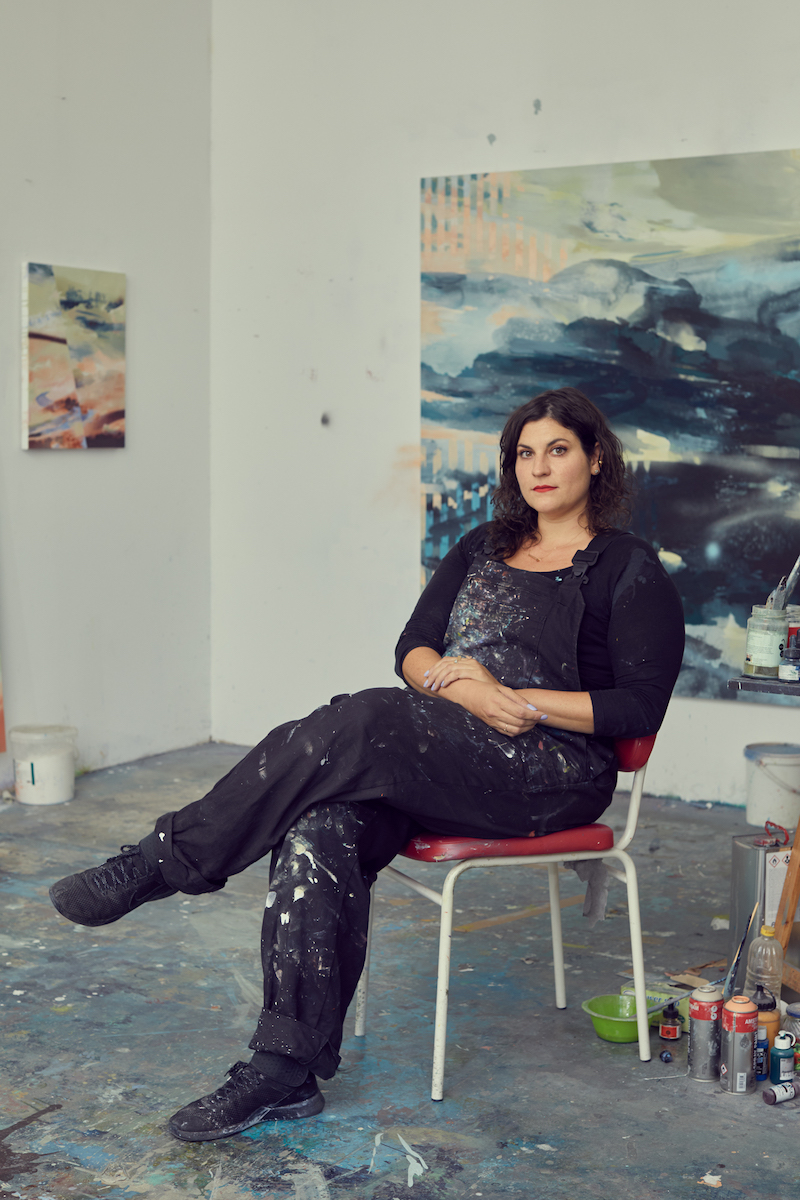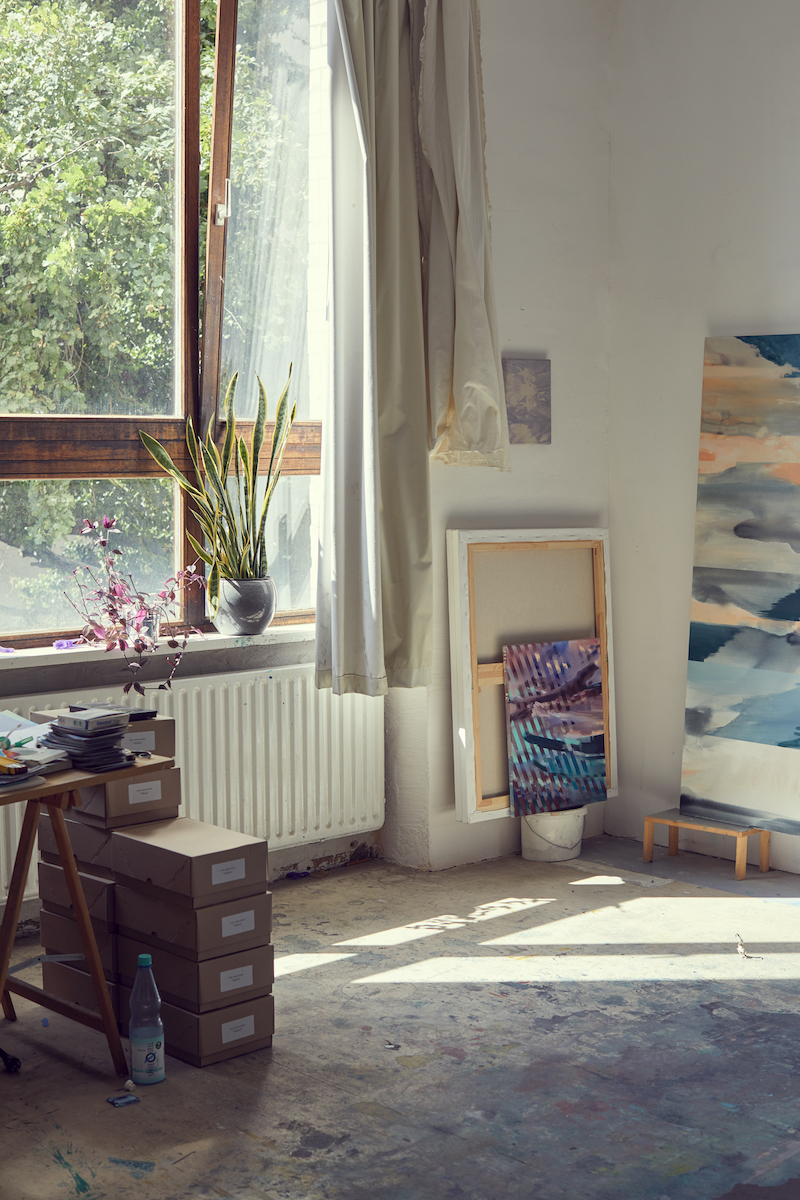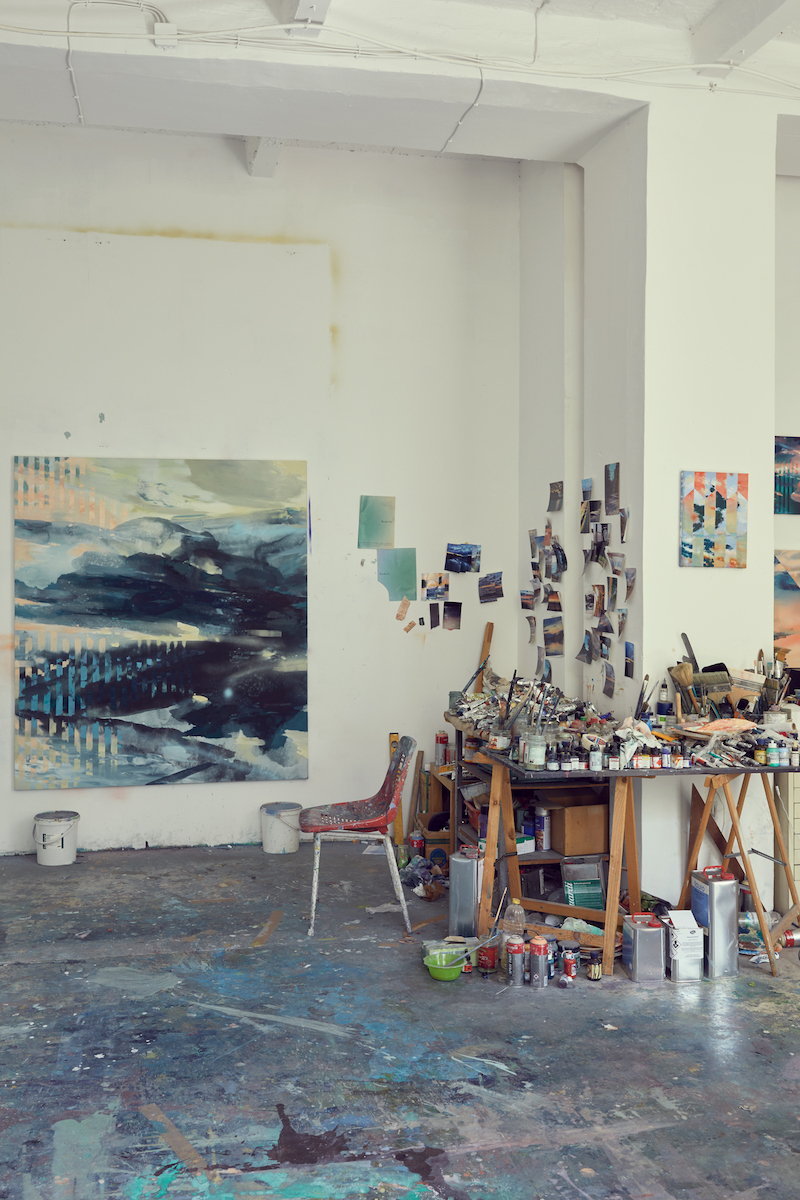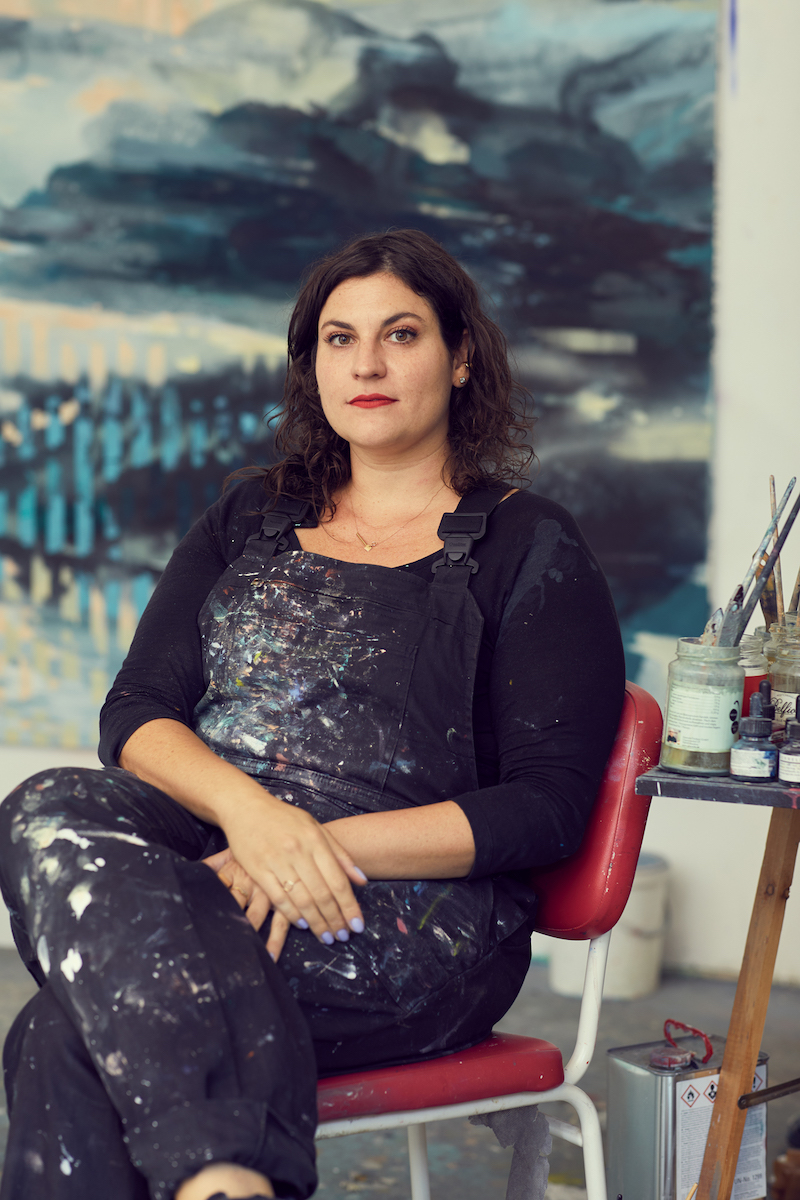by Kimberly Bradley, photos by Martin Müller // Oct. 4, 2022
In a recent visit to Michelle Jezierski’s Berlin studio, writer Kimberly Bradley talked to her about the process of painting and more specifically, the genre of landscape painting. In Jezierski’s case, one could consider landscape as the format through which she explores perception, order and chaos. Dreamy outdoor scenes are made with washes of mostly pinks, blues and purples, that are in turn fragmented and intersected with geometric forms. The resulting canvases have the look of a collage, which is a form that Jezierski also uses to contrast the fluid quality of paint with the hard edge of a cut. The title of her recent monograph ‘Simultaneous Spaces,’ (2022), from which an excerpt of the conversation between Jezierski and Bradley is published below, speaks to this juxtaposition and layering of spaces. Sometimes a scene looks disjointed, as if parts of the picture have shifted from their original position, and at other times different images seem to be woven together.
Landscape, as Jezierski notes in the interview, is “a metaphor for different states of being.” Rather than focusing on the being itself, she focuses on the environment around it—that which is seen and the complexities involved in the process of seeing. She highlights not only the very personal ways an individual perceives the world, but the idea that the individual also exerts their agency in the world.

Kimberly Bradley: Why are you interested in the feeling of landscape, and how do these interruptions evoke that feeling? This is the crux of abstract painting.
Michelle Jezierski: I never wanted to illustrate a specific scene. Art history is filled with landscape painters, so why paint a landscape? But landscape in the broadest sense—sky and earth—is the perfect playground in which to explore space. The horizon is all the information you need. A landscape doesn’t tell you how to read it. It’s what’s happening in you. I want to translate this onto the canvas. I infuse glitches into the experience: this element is important, because it’s very much of our time.
KB: Your glitchy geometries are not fixed, though, like the strictness of Agnes Martin’s grids and stripes: They’re recurrent but not rigid—they seem more percussive than structural.
MJ: In some ways it’s about rhythm as the interruption of pattern, and the different movements of the interruption. Here we have the musical aspect I just mentioned. I grew up in a musical family. My parents are both classical musicians, and I also played music for many years, so music influences my work. Coming from this background, rhythm is important. In music, the beat adds structure. In my paintings, the geometries add structure as well, but these geometries are imperfect. I don’t plot out my work; it all happens directly on the canvas as a dialogue between me and the surface. These marks are irregular because they’re human, and different from what a computer would do. I find perfection boring.
KB: You don’t plot at all?
MJ: No. First I set the tone with colors and pour the ink and think of an atmosphere I would like the painting to start with. My life and what’s happening in the world can affect this. I absorb my surroundings—so each work comes from a mix of intuition and reactions.
KB: What within you makes you create a certain external atmosphere? I was just rereading the diaries of the late Romanian artist Geta Brătescu, ‘Apparitions’ (2017). In it she asks: “But what does it mean to be an artist? It means being the receptacle in which there occurs the chemistry that transforms experience into expression. The fable of the alchemist, the transformation of gross matter into noble matter, into gold, is a story about art.” Is it like this for you?
MJ: It’s like looking at the ocean that can change all the time, depending on the day. In a good painting, something can also change every time you look at it. It can be stormy; it can be calming. It can be those things at the same time. There’s no set mood. Time, too, is fascinating. When you look at sculptures, you see things from different angles within a span of time. In the works I’m doing now, I’m trying to grasp the multitude of aspects in the world, and within us emotionally. In one work, ‘Loop,’ there’s just one big break. It’s about playing with time, and the feeling of passing time, looping time, and repeating time. Some of the gestures are done quickly. Then come breaks that overlay the gesture and interweave with it. They of course almost negate and augment the gesture.

All this is why I feel that landscapes are a metaphor for different states of being. I’ve sometimes tried to let the gesture have more space. And then there are paintings where the grid, line, or geometry has more space. It’s a constant battle between the two. I’m fascinated by the separation between gesture and the pure line. I think of Robert Irwin, one of my absolute favorite artists from the Light and Space movement in southern California in the 1960s, which was a kind of backlash to Abstract Expressionism. He was a painter until he realized that each mark that you make has such gravity that he became too self-conscious to paint. Ever since, he has used light as his medium. He wrote one of my favorite books, about forgetting to see the thing one sees. In almost each sentence, it can be read in a contemplative way (‘Seeing Is Forgetting the Name of the Thing One Sees,’ 1982—Ed.).

KB: Do you forget the name of the thing you’re working on, or even the thing itself, when you’re working?
MJ: Yes, because it’s not important. Irwin talks about perception: what you see is what you get, but what you don’t get, you don’t see. He leaves a lot to the viewer. In the foreground is his perception and what he can do in order to enrich our perception.
KB: Your paintings have a wide range of formats and complexity, and evoke different registers of perception.
MJ: You know, there’s Mahler’s orchestral music and there’s techno. Both create soundscapes and expansiveness that evoke vastness and depth. But like music, my artworks have different intensities. Feelings or states are also like frequencies, or heartbeats. Your pulse can be quick or very slow, but it’s still a heartbeat. I do believe in universal frequencies. If you look at the bottom of the ocean, there are ripples in the sand. But that pattern can repeat in the clouds in the sky. There are different molds of material, but basically, it’s the same thing.

Artist Info
Additional Info
DCV
Michelle Jezierski: ‘Simultaneous Spaces’
Book Launch: Saturday, Oct. 8, 2022; 5–7pm; RSVP here
Talk with Michelle Jezierski, Jeni Fulton, Kimberly Bradley: Friday, Oct. 8, 2022; 5:30pm
dcv-books.com/…/michelle-jezierski-simultaneous-spaces
Sammlung Glampe, Südstern 6, 10961 Berlin; click here for map




















